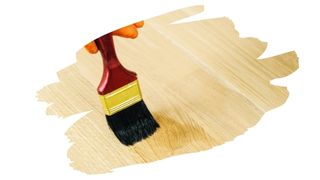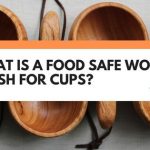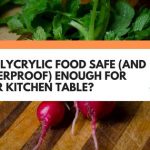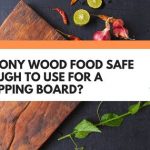The most durable high gloss wood finishes tend to have additives and chemicals in them. But, those additives can mean these finishes aren’t always the safest thing to use in your kitchen.
So, in this post, we explain the difference between a food safe and food grade wood finish — and why it matters for food safety. You will also discover which food safe wood finish will leave behind a high gloss surface — with no buffing required.
And keep reading to discover the two safest wood finishes you can use to seal a cutting board.

This post may contain affiliate links to products that we receive a commission for (at no additional cost to you). Learn more here.
What’s The Best Food Safe Wood Finish?
Arguably, any food safe finish is one that contains US FDA certified food safe resins and coatings.
Now, where people may get a little confused is in the meaning behind the term ‘food safe’. You see, food safe does not mean that it is a surface safe enough for direct food contact.
Food safe finishes are only deemed safe enough for indirect contact with food. Which is why you can find food safe chemical paints, and even food safe solvent-based sealers.
But, if you want a wood finish that is safe enough for you to eat your dinner on, then it should be a food grade finish.
You can learn more about the FDA’s list of food-safe resins and coatings over on their website here.
And What Is A Good High Gloss Food Safe Wood Finish?
The best eye-popping high gloss wood finishes, are shellac and lacquers. It’s fairly easy to buff these finishes out into a shiny coat.
In fact, shellac in particular, is a naturally sourced food safe wood finish. And, in it’s raw form, you could argue that it’s as close to a solid food grade glossy finish as you can get.
But, shellac is often sold in a ready-to-apply liquid form that includes the addition of toxic high-proof alcohol. And that alone means that store-bought shellac finishes are often not food-grade.
Related Post: Is Shellac Food Safe Enough For A Cutting Board?
Is There A Food Safe Polyurethane? Yes, provided that polyurethane finish contains FDA certified food safe substances. Even then, only after that polyurethane has dried and cured, can it be deemed a food safe surface.
So What’s The Least Toxic Wood Finish?
The least toxic wood finishes are consumable food grade finishes.
Food grade finishes are wood finishes that are safe enough to have direct contact with food. Which means that they don’t leach any dangerous toxins or substances.
But, most importantly, if they happen to become ingested, they don’t pose any toxicity harm to us.
Which is why the best food grade finishes are highly filtered, such as Mineral oil or Fractionated Coconut oil.
But Why Isn’t Food Safe The Same As Food Grade?
It’s because food safe finishes contain chemicals and other ingredients that aren’t safe for human consumption.
Still, once these wood finishes have dried and cured, they are safe in a kitchen setting. But, there are still risks inherent in even bits of a cured food safe wood finish getting into your meal.
What’s more, just because a food safe wood finish is cured, does not mean it is insurmountable.
Some food safe finishes can become chipped or cracked, allowing thin splinters of them to come off. In other cases, they can begin to break down due to heat, alcohol, or even vinegar.
Which is why you shouldn’t use food safe wood finishes to coat food prepping items, such as cutting boards and wooden spoons.
So How Do You Seal Cutting Boards And Wooden Spoons?
You can use pure food grade wood finishes, such as 100% pure food grade mineral oil.
Food grade mineral oil is made from distilled petroleum, (yep, this is the same thing diesel comes from). However, it has been highly refined, so it is no longer toxic.
You can find this stuff sold at any local pharmacy, and it works like any other penetrating oil finish. Food grade mineral oil will sink right down into the grain of your cutting board, preventing it from absorbing too much moisture.
Related Post: Walnut Oil Vs Mineral Oil: Which One’s Better For Your Cutting Board?
Now, mineral oil is pretty much the gold-standard when it comes to food grade finishes.
But, you’d be forgiven if you found the petroleum aspect of mineral oil a little off-putting. In which case, one alternative food grade oil finish comes in the form of fractionated coconut oil.
This oil is very different from regular culinary oil in one key aspect; it is heavily filtered.
In fact, it is so well filtered, that this watery version of coconut oil never goes rancid. So, you can use this oil to condition your cutting board and spoons without worrying about it ever going off.
To learn more about this food grade oil finish, you can check out our post here: What Will Fractionated Coconut Oil Do To Your Cutting Board?
Related Post: The Reason Why An Olive Oil Wood Finish Will Go Rancid (Revealed!)
And Are These Food Grade Finishes High Gloss?
Both of these finishes can leave behind a somewhat glossy appearing surface. For a very brief time. However, neither one of these wood finishes are durable.
That is because both mineral oil and fractionated oil are what are referred to as non-drying oils. Which means that these oils will not dry, cure, or harden, like a Linseed or Tung oil finish can.
Related Post: Is Linseed Oil Food Safe Enough To Use On A Cutting Board?
So, if you wash a cutting board often enough, you’ll inadvertently rinse away these food grade finishes.
To Wrap Up, Here Are The 3 Key Takeaways From This Post…
- 1). Food safe wood finishes are safe enough to use in areas where they will have indirect contact with food.
- 2). But, a food grade wood finish is safe enough to use on surfaces that’ll have direct contact with food (i.e. cutting board).
- 3). The best high gloss food safe finish is shellac. It’s fairly easy to buff this finish out into a mirror-like shine.
References:
FDA Compliant, Food Grade and Food Safe | Industrial Specialties Mfg. & IS MED Specialties



